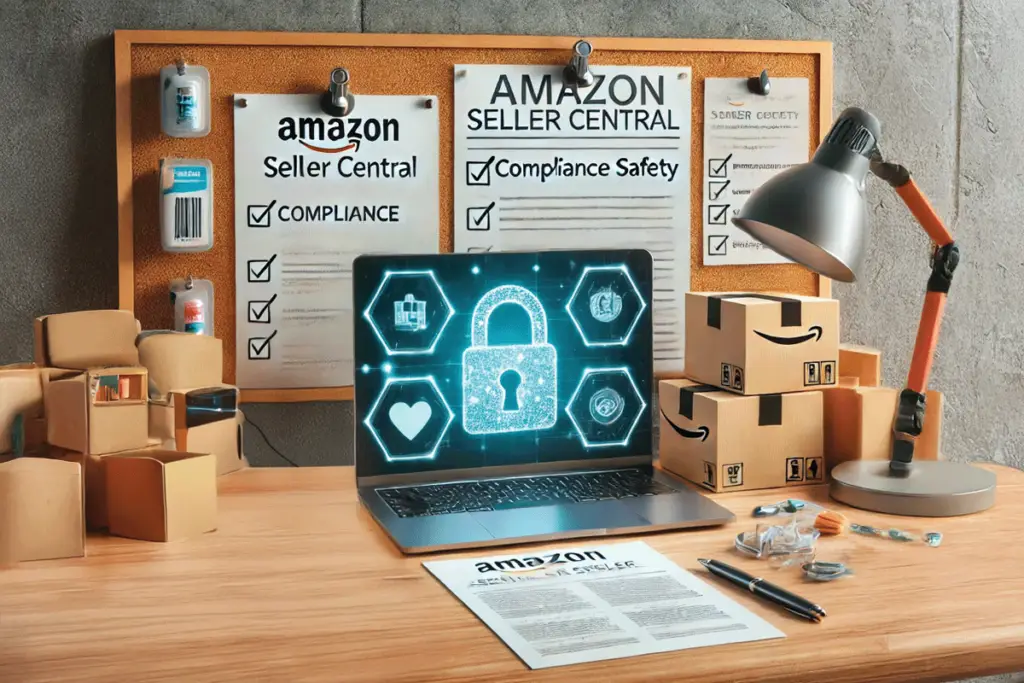Product Compliance Safety for Amazon Sellers

What Sellers Must Know to Avoid Suspensions
Selling on Amazon is more than just listing products and shipping them out. If your products aren’t compliant with safety standards, your entire Amazon business could be shut down overnight.
Amazon takes product safety seriously—and so should you. One safety slip-up can lead to immediate product removals, account suspensions, or even legal trouble. And if you think, “It won’t happen to me,” think again. Amazon enforces its compliance rules aggressively through automated systems, customer complaints, and even competitor reports.
In this guide, we’re breaking down everything you need to know about product safety and compliance as an Amazon seller—without the legalese. Learn how to protect your listings, keep your account safe, and avoid costly mistakes.
1. The Most Common Compliance & Safety Issues on Amazon
Biggest Mistakes That Get Sellers in Trouble
Let’s start with the basics. Here are the most common compliance errors we see:
Missing or incorrect product labeling
Lack of required testing documentation
Listing restricted or prohibited items
Failing to disclose ingredients or warnings
Selling counterfeit or expired products
Amazon’s algorithms pick up on a lot of this, but you’re also at risk from manual reviews, buyer complaints, and even sneaky competitor reports.
Real-World Safety Violations Amazon Cracks Down On
Sellers have faced suspensions for:
Selling children’s toys without proper small parts warnings
Listing supplements with unapproved health claims
Importing electronics without proper voltage certifications
Offering beauty products with banned ingredients
Sending unlabeled hazardous materials
Amazon doesn’t give warnings in many cases—it simply removes the product or suspends the listing, and you’re left scrambling.
How Amazon Enforces Compliance
Amazon uses:
Automated compliance checks during listing creation
Customer feedback and safety complaints
Random audits of documentation
Competitor flagging mechanisms
Marketplace product reviews for recurring issues
One complaint might trigger an investigation. Several complaints could get your listing pulled. Lack of documentation? You’re off the platform.
2. Amazon’s Must-Know Compliance & Safety Standards
Regulations Sellers Must Follow
Depending on your product category, you may be required to follow rules from:
Consumer Product Safety Improvement Act (CPSIA)
FDA (for supplements, food, cosmetics)
FCC (for electronics)
EPA (for pesticides and disinfectants)
Hazardous materials restrictions (lithium batteries, aerosols, etc.)
And don’t forget state-level requirements, like California’s Proposition 65.
High-Risk Product Categories
Some categories are riskier than others. Here are a few that Amazon pays special attention to:
Toys and children’s products
Health supplements and vitamins
Topicals, creams, and cosmetics
Electronics and batteries
Household cleaning supplies and chemicals
If you sell in one of these categories, Amazon may require lab testing, certification, and pre-approval before you can even list.
Amazon’s Documentation Requirements
Amazon frequently requires the following for high-risk items:
Children’s Product Certificates (CPCs)
Lab testing results from CPSC-accepted labs
FDA registration or documentation
Material Safety Data Sheets (MSDS)
Proof of insurance and brand authorization
Fail to upload these documents on demand, and you’ll lose your listing.
3. How to Ensure Your Products Are Compliant Before Listing
Your Pre-Listing Compliance Checklist
Before you even think about hitting “publish” on a new listing, follow this step-by-step guide:
Identify applicable regulations (CPSIA, FDA, FCC, etc.)
Send your product to a certified third-party lab
Review packaging and labeling requirements
Create necessary documentation (CPC, MSDS, etc.)
Double-check for restricted ingredients or features
Upload compliance documents to Amazon before listing
Bonus tip: Always check Amazon’s category-specific compliance guidelines in Seller Central.
Where to Find Third-Party Testing Services
Look for:
CPSC-accepted labs for children’s products
FDA-compliant labs for food and cosmetics
Accredited testing services for electronics (UL, Intertek, SGS)
Reputable providers include:
QIMA
TÜV SÜD
Bureau Veritas
Intertek
UL Solutions
Hiring a compliance consultant or using Amazon’s Service Provider Network can also be a smart investment—especially if you’re scaling quickly.
Proactively Reduce Risk
Don’t wait for Amazon to flag your listing. Be proactive:
Maintain documentation for all SKUs
Conduct internal audits quarterly
Use barcode scanning tools to track unsafe listings
Regularly update your product safety knowledge
Remember, staying compliant is cheaper and easier than fixing violations later.
4. What to Do If Amazon Flags Your Product for a Compliance Violation
Step 1: Investigate the Issue
Start by:
Reading the performance notification carefully
Checking for missing or outdated documentation
Reviewing recent customer complaints or returns
Analyzing ASIN-level issues (Amazon will often reference them)
Identify the root cause—don’t just guess.
Step 2: Appeal the Suspension (The Right Way)
If your product or account gets suspended, here’s a simple appeal framework to follow:
Subject: Product Compliance Appeal – [ASIN]
To Amazon Seller Performance,
I am writing to appeal the removal of [Product Name / ASIN] due to a compliance concern. After a thorough review, we have identified the issue and taken corrective actions as follows:
Root Cause: [Brief explanation – e.g., missing lab report, incorrect label]
Corrective Action: [What you did – e.g., updated documents, new lab testing]
Preventative Action: [What you’ll do going forward – regular audits, staff training]
We’ve uploaded the necessary documents to the case and are committed to full compliance with Amazon’s product safety policies.
Thank you for your consideration.
Sincerely,
[Your Name / Business]
What NOT to Do
Don’t submit multiple appeals in a panic
Don’t argue with Amazon or blame customers
Don’t send vague responses—be specific
Don’t ignore documentation requirements
Don’t rely on guesswork—know the regulations
5. Best Practices for Staying Compliant & Avoiding Future Issues
Set Up a Quality Control Process
Quality control isn’t just for manufacturers. As a seller, you should:
Inspect shipments before they’re sent to Amazon
Require compliance testing from suppliers
Check product labeling, packaging, and documentation
Spot-check inventory for defects or issues
Monitor for Safety Issues
Keep an eye on:
Customer reviews that mention safety concerns
Return reasons in your Seller Central reports
Amazon warnings or compliance performance notifications
Flag and remove products that pose a potential risk.
Conduct Ongoing Compliance Audits
Every quarter, run a mini audit:
Are all documents still valid and up to date?
Have any laws changed (like Prop 65)?
Are you using new suppliers or manufacturers?
Have you launched new product types?
A little time now can save your account later.
When to Get Legal Help for Compliance Issues
Sometimes, DIY fixes just aren’t enough. If you’re dealing with:
Serious account suspension for safety violations
Legal threats from customers or competitors
Counterfeit or product liability accusations
Government agency inquiries (FDA, CPSC, etc.)
Customs seizures or imports flagged as non-compliant
It’s time to bring in legal support.
At AmazonSellersLawyer.com, our legal team helps sellers respond to complex compliance issues, draft strong appeals, and defend their businesses from lawsuits and Amazon enforcement actions.
🚨 We do not offer free consultations, but if your issue is serious, reach out now—we’ll assess whether we can help.
Final Thoughts: Don’t Let Compliance Kill Your Amazon Business
Amazon’s product safety rules aren’t going anywhere. In fact, they’re only getting stricter. The good news? Sellers who stay informed and proactive can avoid suspensions, protect their revenue, and build long-term businesses.
✅ Stay compliant.
✅ Keep documentation ready.
✅ Don’t wait for a takedown notice.
And if you need legal help, AmazonSellersLawyer.com is here to guide you through it—step by step.
